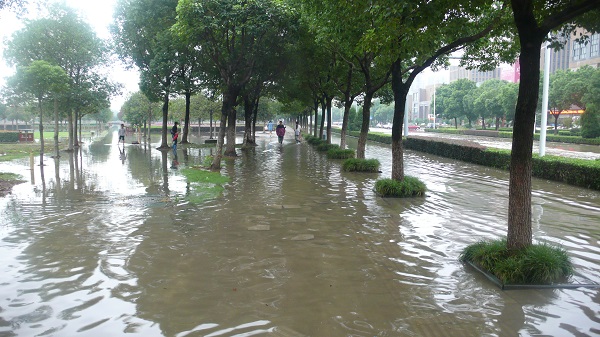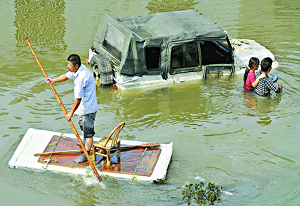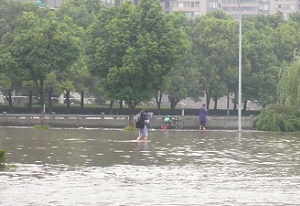
February 19, 2014, by Blue-Green team
A Blue-Green Approach to Flood Risk Management in Asia’s Mega-deltas?
Can we adapt the Blue-Green approach for flood risk management and make it a suitable alternative to traditional hard engineering for addressing some of the flooding issues in Asia’s urban mega-deltas?
After hearing about the severe flooding that affected Ningbo (and surrounding areas in Zhejiang), China, in mid-October 2013, I have been reading up on some of the flood risk management strategies in Asia, and particularly, in the urban mega-delta cities.
Nottingham University has a campus in Ningbo (University of Nottingham Ningbo China, UNNC) which was inundated during the October floods (seen here on the UNNC student TV channel, NUTS). Faith Chan, a lecturer in Environmental Science, has provided me with some details and images. The flooding in Ningbo was severe with more than 100,000 houses inundated and 5 deaths. The flooding occurred as storm surges combined with intensive rainfall and overwhelmed the drainage system so surface water could not infiltrate. This also caused the fluvial system to overflow.
Ningbo is one of Asia’s coastal mega-cities; high population density (>8 million) and a key area for national economic and industrial development, and ranked in the top 20 for flood risk in 2070, both in terms of exposed assets (ranked 11th) and population at risk (ranked 14). Ningbo is located on the Yangtze River Delta. Hard engineering has been used but often cannot mitigate the 1 in 100 year storm; climate change and subsidence of the delta means that many hard engineering measures cannot offer the degree of protection that they were initially designed for. Like many of the Asian coastal mega-cities, increased incidents of flooding have occurred which are expected to again increase under potential future climate change. Faith Chan’s 2012 paper on “Flood risk in Asia’s urban Mega-deltas” addresses some of the drives, impacts and responses to possible flood risk management strategies, stating that “flood risk management appears to suffer through lack of sufficient strategic planning, and the difficulty in defending deltaic cities through traditional engineering approaches alone”. There is also a disconnect between planning and flood management (Zhou & Cai, 2010).
The Blue-Green concept therefore may be urgently needed to address flood risk management in Asia, and be a key proponent of sustainable planning to address both natural hazards and quality of life; the multiple benefits that could accrue from such solutions (environmental, economic, social and cultural) may enhance the quality of living in such crowded urban environments. Building flood resilience through a ‘making space for water‘ approach, as has been adopted in areas of Europe (e.g. Netherlands), the US and Australia, could be a viable option BUT this will need to be made appropriate for the site in question and the socio-cultural dynamics of the Asian mega-cities. Most likely, Blue-Green will work with the existing grey infrastructure.
As Chan et al., (2012) state, “wetland restoration, SuDS and artificial flood storage facilities may be more viable than attempting to defend all vulnerable people and assets”. This requires greater exploration and serious consideration as an approach. Owing to the nature of the delta, flooding is naturally unavoidable and can positively enhance biodiversity and agriculture (Syvitski et al., 2009). BUT not when this is covered in impermeable surfaces and industrial, commercial and residential developments.
A sustainable flood risk appraisal for the Pearl River Delta (which encompasses 11 cities including Hong Kong) is given in Chan et al., 2013. Building on flood resilience rather than flood defense may be the way to prepare Asian mega-cities and mega-deltas and mitigate some of the future risks of flooding.
More information on the Blue-Green Cities international collaborations can be viewed on the website.
Blog post by Emily Lawson.
No comments yet, fill out a comment to be the first



Leave a Reply